

A short video on Larry's water-screening method.

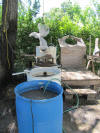

 Here's the set-up, for water-screening micro-drills and fragments, at our
lab. The bags are suspended from a rope> water is sprayed into the samples, and
the dirt and water fall into the barrel. When the first barrel is full the water
flows into the second, third, and fourth barrels. By the time it gets to the
fourth barrel (blue barrel), it is clarified enough to recirculate. The
recirculation is done with a small sump-pump. It pumps the water, in the fourth
barrel, back to the sample. The water is used over and over until it gets full
of silt.
Here's the set-up, for water-screening micro-drills and fragments, at our
lab. The bags are suspended from a rope> water is sprayed into the samples, and
the dirt and water fall into the barrel. When the first barrel is full the water
flows into the second, third, and fourth barrels. By the time it gets to the
fourth barrel (blue barrel), it is clarified enough to recirculate. The
recirculation is done with a small sump-pump. It pumps the water, in the fourth
barrel, back to the sample. The water is used over and over until it gets full
of silt.
 We
start with half of a 5-gallon bucket of soil.
We
start with half of a 5-gallon bucket of soil.
 The sample is placed in the middle of the fiberglass screen, and the ends of
the screen are folded together to form a bag.
The sample is placed in the middle of the fiberglass screen, and the ends of
the screen are folded together to form a bag.
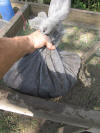 Then, the bag is gathered together so no material can escape, and the rope is
attached around the bags mouth.
Then, the bag is gathered together so no material can escape, and the rope is
attached around the bags mouth.
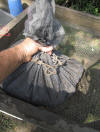 Next, the bag is cinched, with the rope.
Next, the bag is cinched, with the rope.
 Now, a half-hitch is added, to cinch the knot tighter so no material can leak
out.
Now, a half-hitch is added, to cinch the knot tighter so no material can leak
out.
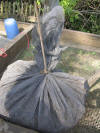 Then, baking soda is added to about 1/3 bucket of hot water.....
Then, baking soda is added to about 1/3 bucket of hot water.....  ...and the sample is placed in the bucket to soak...
...and the sample is placed in the bucket to soak...
 ...for about 1/2 hour, or so. I soakk four separate samples so I can work on
one while the rest are still soaking
...for about 1/2 hour, or so. I soakk four separate samples so I can work on
one while the rest are still soaking
 After soaking, the bag is fastened to an over-hanging rope with a simople
wooden stave.
After soaking, the bag is fastened to an over-hanging rope with a simople
wooden stave.
 This is done so the samples can be removed and/or readjusted without
having to untie any knots.
This is done so the samples can be removed and/or readjusted without
having to untie any knots.
 The valve for the main tank is closed and spraying begins.
The valve for the main tank is closed and spraying begins.
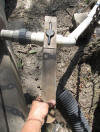
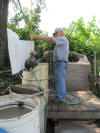 When the main tank becomes too full of silt,...
When the main tank becomes too full of silt,...
 ...the valve is opened and the...
...the valve is opened and the...
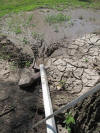 ...soil empties...
...soil empties...
 ...onto an area, adjacent to the tank...Next, the tank is washed. All soil is
saved and will be used to back-fill the original excavation from which it
came.
...onto an area, adjacent to the tank...Next, the tank is washed. All soil is
saved and will be used to back-fill the original excavation from which it
came.
 Then, the samples are removed from the screen...
Then, the samples are removed from the screen...
 ...poured onto a porous cloth...
...poured onto a porous cloth...
 ...the cloth is gathered ...
...the cloth is gathered ...
 ...then, tied...
...then, tied...
 ... and placed into another bath of baking soda and hot water.
... and placed into another bath of baking soda and hot water. After soaking for bout 1/2 hour, the sample is sprayed again to remove all
lingering soil, then hung up to dry.
After soaking for bout 1/2 hour, the sample is sprayed again to remove all
lingering soil, then hung up to dry.
 After about two weeks, the samples are ready to be picked. I usually pick
about 1/2 scoop at a time.
After about two weeks, the samples are ready to be picked. I usually pick
about 1/2 scoop at a time.
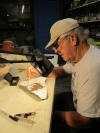 A magnifier is used to....
A magnifier is used to....  ...spot the tiny bits of chert.
...spot the tiny bits of chert.
 Then, the chert pieces are removed to a plastic box, then, a plastic bag, for
later analysis.
Then, the chert pieces are removed to a plastic box, then, a plastic bag, for
later analysis.

Here's what the samples look like after I picked all the chert.
 #3
#3
 #3 close-up
#3 close-up
 #4
#4
 #4 close-up, #1
#4 close-up, #1
 #4 close-up #2
#4 close-up #2
Weighing the samples.
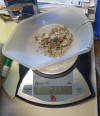 Micro-drills from North 290-East 135
Micro-drills from North 290-East 135

HOME